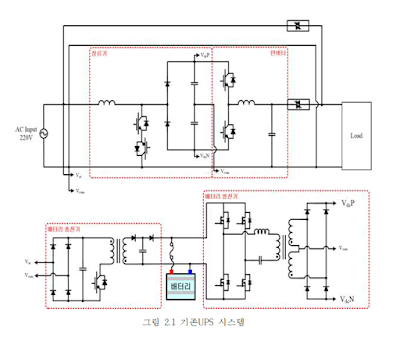terça-feira, 9 de junho de 2015
segunda-feira, 8 de junho de 2015
quarta-feira, 3 de junho de 2015
Study on the Voltage Balancing Inverter for UPS Byeon, Yong Seop Department of Electrical Engineering Graduate School, Myongji University Directed by professor Lee, Jun Young

Study on the Voltage Balancing Inverter for UPS Byeon, Yong Seop Department of Electrical Engineering Graduate School, Myongji University Directed by professor Lee, Jun Young
This paper suggests another candidate the Voltage Balancing Inverter for UPS. Recently A commercial power interruptions and voltage variations of sensitive high-tech equipment for industrial, medical equipment, computers, finance, office equipment, such as the use of high use of digital information processing equipment with high reliability while increasing the uninterruptible power system to the growing reality. In this paper, we propose an inverter circuit forming the voltage balance itself without a separate control element. The proposed circuit is to carry the charge of the voltage relative to the high voltage side of the capacitor using the charge moving toward the low voltage and is naturally to balance. The proposed circuit is not required voltage balance controller can be used as a single controller. Even though the number of switches are more than conventional half-bridge inverter structure that can use a rated voltage of the high-speed switch to a lower half of the rated voltage of the conventional circuit.
The validity of proposed system could be verified by simulations, circuit fabrication and experiments.
quinta-feira, 28 de maio de 2015
ELECTROMAGNETIC FIELD THEORY Bo Thid´e Swedish Institute of Space Physics and Department of Astronomy and Space Physics Uppsala University, Sweden
SURFANDO EN LA WEB ENCONTRE UN GRANDE LIBRO DE LA ACADEMIA DE CIENCIAS DE SUECIA SOBRE TEORIA ELECTROMAGNETICA LO COMPARTO CON USTEDES AMIGOS:
LINK ORIGINAL
http://d.theupload.info/down/j2inh6wqd615y3k9n69br8blgv888zyt/van_wijk_k__electromagnetic_field_theory.pdf
LINK ALTERNATIVO
https://copy.com/Cd8Azxde7o2C2m24
LINK ORIGINAL
http://d.theupload.info/down/j2inh6wqd615y3k9n69br8blgv888zyt/van_wijk_k__electromagnetic_field_theory.pdf
LINK ALTERNATIVO
https://copy.com/Cd8Azxde7o2C2m24
domingo, 24 de maio de 2015
Y. Kadoshima, K. Koiwa, J. Itoh, F. Anne, A. Gerlaud: "Surge Voltage Suppression Methods for Three-phase to Single-phase Matrix Converter", The Applied Power Electronics Conference and Exposition 2015, Vol. , No. , pp. 115-121 (2015)
Y. Kadoshima, K. Koiwa, J. Itoh, F. Anne, A. Gerlaud: "Surge Voltage Suppression Methods for Three-phase to Single-phase Matrix Converter", The Applied Power Electronics Conference and Exposition 2015, Vol. , No. , pp. 115-121 (2015)
Abstract—This paper discusses surge voltage suppression methods in order to design a large capacity three-phase to single-phase matrix converter which is used in AC-DC converters. In order to reduce the surge voltage, the design criteria based on the flow chart of a laminated bus bar (LBB) for the three-phase to single-phase matrix converter is clarified to achieve the lowest stray inductance. As a result, the maximum stray inductance of the LBB for 200-V, 50-kW is achieved to 59 nH in simulation and 58.3 nH in experiment. Besides, when the surge voltage exceeds the tolerance, a snubber capacitor is used in order to limit the surge voltage. In this paper, the design method of the snubber capacitor is also proposed. Concretely, the relationship among snubber capacitance, surge voltage and turn-on loss is derived. As the result, it is confirmed that the surge voltage becomes 231 V when the output current is 310 A by experiment. Thus, the design method of snubber capacitor to suppress the surge voltage is validated.
FULL PAPER LINK ORIGINAL
three-phase to single-phase matrix converter; surge voltage suppression; laminated bus bar; simple AC snubber
sábado, 23 de maio de 2015
Switching Loss Reduction of AC-AC Converter using Three-level Rectifier and Inverter for UPS. Kazuki Yoneda, Hiroki Takahashi and Jun-ichi Itoh Dept. of Electrical, Electronics and Information Engineering Nagaoka University of Technology Nagaoka, Niigata, Japan
Abstract— This paper proposes an AC-AC converter, which consists of T-type three-level rectifier and inverter, for an on-line UPS. The switching loss of the proposed AC-AC converter is drastically reduced because the proposed converter is driven at a very low switching frequency which is six times of input side frequency. The T-type rectifier separates the maximum phasevoltage, medium phase-voltage and minimum phase-voltage from the input voltage. Next the output waveform is built by the T-type inverter from each maximum phase-voltage, middle phasevoltage and minimum phase-voltage. The proposed circuit can achieve not only high efficiency, but also short instantaneous interruption time. Furthermore, the proposed AC-AC converter compensates a voltage dip with changing an operation mode of a rectifier. In this paper, the fundamental operation of the proposed converter is confirmed by simulations and experiments. In addition, the power loss of the proposed converter is compared to a conventional on-line UPS and the efficiency of the proposed converter is 97.1% at rated load in an experiment.
FULL PAPER LINK ORIGINAL NA WEB
http://itohserver01.nagaokaut.ac.jp/itohlab/paper/2014/141105_peac2014/yoneda.pdf
LINK ALTERNATIVO
https://copy.com/LkWFpaxB26DaKPAI
quarta-feira, 6 de maio de 2015
A Novel Single-Phase Cascaded Multilevel AC-AC Converter Without Commutation Problem Kim, Sang-hun Department of Electrical Engineering Graduate School, Kyungpook National University Daegu, Korea
ABSTRACT
A Novel Single-Phase Cascaded Multilevel AC-AC Converter Without Commutation Problem Kim, Sang-hun Department of Electrical Engineering Graduate School, Kyungpook National University Daegu, Korea (Supervised by Professor Kim, Heung-Geun) Abstract) This paper presents a novel cascaded multilevel PWM ac-ac converter that can solve commutation problem. By cascading the single-phase PWM ac-ac converter that uses basic switching cell structure and coupled inductors, the proposed converter does not need to sense the voltage or current polarity for safe commutation. When many unit-cells are cascaded, the proposed converter has more output voltage levels and can obtain high ac output voltage by using low voltage rating switching devices. By applying phase-shifted PWM technique, the proposed converter can reduce output filter size significantly. A 2 kW prototype converter having four unit-cell structure is built and tested to verify the performance.
Assinar:
Postagens (Atom)


















































 JOSIL ARTISTA PLASTICO FORTALEZA CEARA BRASIL AV.HERACLITO GRAÇA 41 TEL(85)32542378
JOSIL ARTISTA PLASTICO FORTALEZA CEARA BRASIL AV.HERACLITO GRAÇA 41 TEL(85)32542378
















